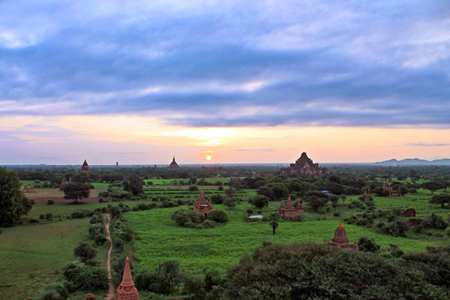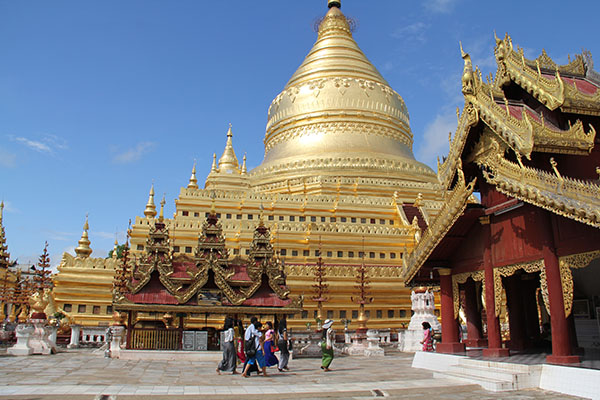"There is a country far nobler than any, a land that brings joy to the heart; and it is called Bagan."
It was so inscribed on stone in the mid-14th century by order of one queen of the Pyina dynasty that followed Bagan's fall. By then, Bagan's greatness had waned, its capital deserted but for this queen and for centuries it was "a country far nobler than any". Before a Bagan tour takes you to this magical landscape, let's have a look at some essential information about the region.
Bagan was also called Arimaddana Pura meaning "Crusher of Enemies" but this ancient city is best loved for its message of peace enshrined in the thousands of temples left today, over an area of 16 square miles. Bagan was variously spelled Pukkam, Pukam or P'u- kan, its first mention made in the old Mon script datable to 1093.
A document titled Linguai-tai-ta dated 1178 CE and written by Chou Ch'u-fei, a Chinese official, recorded the visit of Myanmar emissaries to the Chinese court in 1004 and 1106 and described this kingdom to their west: "The king and officials of 'P'u-kan Kingdom' all wear on their heads caps shaped like the rhinoceros horn. They have horses but ride them without a saddle. The king's residence has tiles made of tin. Gold and silver are used for the interior decoration of rooms.
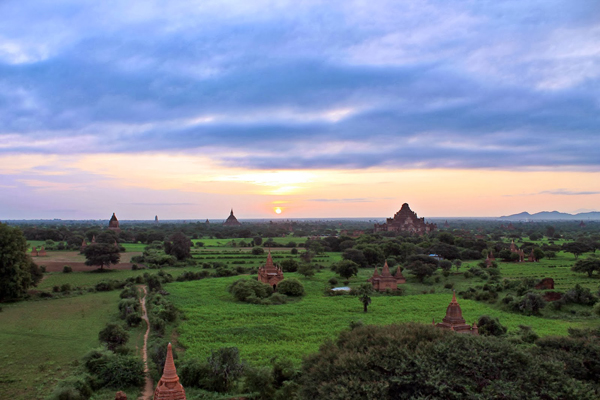
They have several tens of Buddhist monasteries. The monks all wear yellow robes"... as they still do. Men wearing caps 'shaped like the rhinoceros horn' can be seen in the wall paintings of Kyansittha Umin CaveMonastery. Another Chinese chronicle Chu-fan-chih written by Chao Ju-kua in 1225 CE mentioned emissaries sent to the 'Pu'kan Kingdom' in 1004, where they saw a lamp festival celebrated on 8 February 1004.
The old coded Bamar saying "Sweet sounds of cartwheels count the temples of Bagan" meant that the temples used to be 4446 in number. Many were damaged in the earthquake of 1975. According to the 1993 report by the Department of Archaeology, 2230 remain, mostly of red brick. To be exact, 524 stupa such as the Shwezigon Pagoda, 911 temples, 416 monasteries, and 379 cave pagodas, meditation centers, ordination halls, libraries, etc. The buildings that remain continue to be living places of worship and most of them maintained by the public since the time they were first consecrated.
Preceding Bagan was the Pyu civilization with several kingdoms that flourished between 2nd century BC and 9th century CE. The Pyu were highly cultured Buddhists, a gentle race that left exquisite jewelry as their legacy. Their civilization was built on culture and not military might and hence, they were unable to defend themselves against the invaders from Nan Ch'oa of the east. Their largest kingdom of Srikhetera fell and their civilization faded as survivors assimilated into the growing society of Bagan.
Bagan's greatness was established by Anawrahta, the 42nd king in the Bagan dynasty of 55 rulers; he ascended the throne in 1044 and founded the First Myanmar Empire. Theravada Buddhism was not a new belief by that time but there were also worshipers of Mahayana Buddhism, Hinduism, animism and the Aranavasi sect of Aree priests who were believed to have indulged in magical practices.
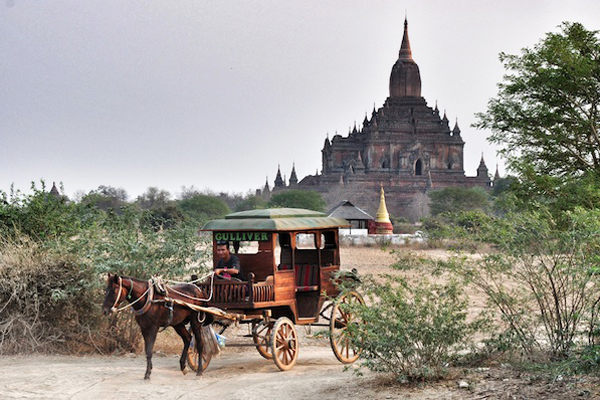
Anawrahta's determination to support Theravada Buddhism with the help of the abbot Shin Arahan left behind, even in the 21st century, a country with the majority of the population of deep Theravada Buddhist faith.
Chronicles relate how Anawrahta invaded the southern Mon kingdom of Suvanabhumi in 1057 to gain the copies of the Buddhist canons. He brought back the Mon king Manuha inscribed on different stone inscriptions as Makuta or Manohor - in chains of gold. On the way, the prisoner king's younger sister Princess Wunna Theingi escaped into the woods of Mt Popa about 30 miles from Bagan. She eventually became the Popa Goddess, a powerful deity in the pantheon of animist worship. In Buddhist lore, celestials and guardians deities exist although the spirits of animism are of a different kind.
Buddhism is basically 'a path to rightful living' and not a religion of worship so animism does not pose a threat. As spirits and their devotees are also Buddhists their belief is tolerated if not practiced by true Buddhists
The story of Bagan is wrapped in mystery and folklore but the heroes are as alive to the people as if they had lived in the last decade and not over ten centuries past. Their stories are not only of faith and war but of romance and heartbreak.
Chronicles tell of how Anawrahta received the gift of Buddha's tooth relic from Sri Lanka which he enshrined at the Shwezigon Pagoda then under construction. It is a Buddhist belief that obtaining a copy of the relic is possible by carving ivory into the form of the original tooth and placing the two next to each other over a period of time.
In this manner, he obtained three copies which were each enshrined in the Lawka Nanda Pagoda on the banks of the Ayeyarwaddy River, the pagodas on top of Tuyin Taung Hill and the last across the river at Tantkyi Taung Hill. Buddhist devotees try to worship at all four pagodas before noon, in the belief that it would make an especially meaningful pilgrimage.
Wherever Anawrahta traveled with a retinue of thousands, he would make clay votive tablets and enshrine them in pagodas. He would incise on the tablets that 'the Great King Nawrahta made this with his own hands so that he may with this merits become an Enlightened One'. The tablets that he made have been discovered as far away as in Twante, a delta town famous since the 5th century for its pottery.
Anawrahta was often honored with gifts from his feudal States, which were at times daughters of the rulers. After giving military assistance to the southern kingdom of Bago, his trusted general Kyansittha was asked to escort Princess Mani Sandar to Anawrahta, a gift from the grateful Mon kingdom. The two young people fell in love but Kyansittha would not betray his lord. When accusations were made by men jealous of Kyansittha that they had committed adultery, Anawrahta had him arrested.
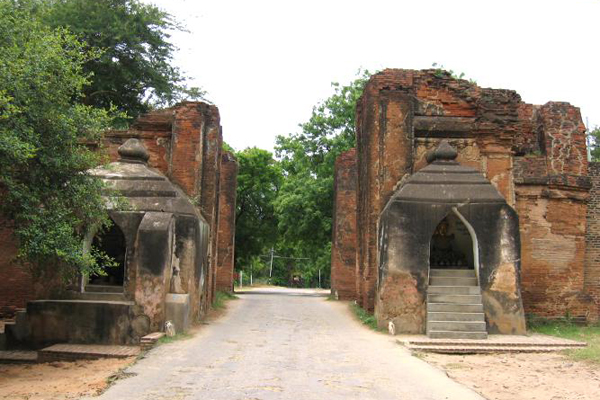
It is said that the king threw his spear at this general he loved like a son, not to pierce the heart but as if by accident, to cut through the ropes that tied him. In this way the king's face was saved, Bago was satisfied that the honor of their princess has been salvaged and Kyansittha freed to live in exile.
Anawrahta's true love, it is said, was Queen Sao Mun Hla, sister of a Maw Shan feudal lord. She was beautiful and intelligent, possessing a mind that matched his in strategic brilliance. A break in Bagan's alliance with her brother forced her to return home. She built several pagodas along her way back and they remain today as symbols of their painful parting.
Caption “Anawrahta forged the First Myanmar Empire that Kyansittha brought to greatness. Bagan's rule covered all of the Menam Valley towards the east, and just six years into Anawarahta's reign Bagan was noted as a great kingdom in the inscriptions of the ancient kingdom of Cham, in a land later to become Vietnam”. The two great kings used military might to unite and expand the kingdom and protected its borders with well-guarded frontier towns and fortresses. They were generous and compassionate towards those they conquered. For their people, they built dams, canals, and lakes to increase agricultural production. Kyansittha was a wise ruler who strengthened diplomatic relations with the Mon kingdom in the south and with the Sung period China where he sent emissaries and cultural troupes, developing peaceful relations that were to last two hundred years.
Not a contemporary record but by its detail very likely accurate, Chinese records of 1343 noted that in 1106 Bagan was a large and powerful kingdom that should be treated with honor. Kyansittha enlarged the Shwezigon that was Anawrahta's merit by encasing it with a slightly bigger structure of the same shape. The two kings were like father and son and in all probability, Kyansittha desired to create a pagoda with a combination of their merits, for the Buddhists believe that merits shared in this way meant reconnection in future lives.
Life and Death, after all, take uncountable turns in the circle of Samsara, which can be broken only when one reaches Nirvana through meditation and merit.
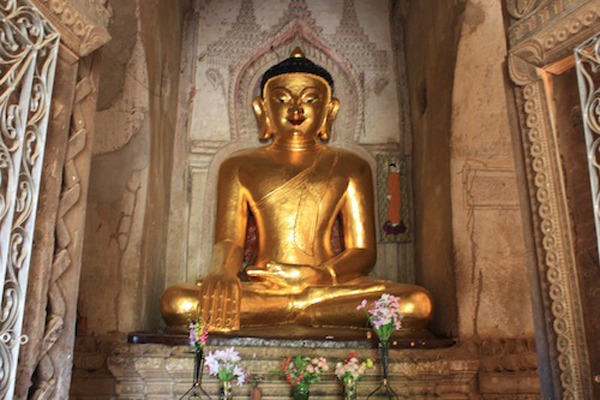
The inscription on a bell donated by Kyansittha at the Shwezigon Pagoda said that "People who weep in sorrow the king shall comfort, wiping the tears from their faces. With the left hand, the king shall bring clothing while with the right he shall give rice and food. Like a mother cares for her child so the king shall look after the people."
Caption “Almost all of the construction took place from the late 11th century of Kyansittha's reign until the death of Narathiha Pati in 1287. To support the Sangha Order, monasteries and meditation centers were built of brick; libraries and Ordinations Halls were not forgotten.”
Palaces and residences, however, were of wood. A great fire of 1225 destroyed most of Bagan while the temples and monasteries were undamaged.
Society of all levels and trade of many kinds of prosperity. Since Bagan enjoyed trade and diplomatic relations and religious exchanges with many countries in the region, within the kingdom there were also those of other faiths. Brahmin astrologers serving at court had their own community.
Some temples were decorated with paintings that looked Indian in origin so immigrant artists might have been used. Those few who are Mahayana Buddhists incorporated their deities in the artwork of Theravada Buddhist temples, not as antagonists but as friendly celestials, a practice continued to the time Christian missionaries arrived centuries later when winged cherubim flew next to Buddhist celestials on the carved panels of teak monasteries. Anawrahta's kingdom has faded into history but his legacy remains intact in the peaceful ways of Buddhism. A tangible sense of tranquillity permeates the air of modern-day Bagan, generated by a thousand years' devotion of the Buddhist pilgrims. Harmony, compassion, and contentment remain heartfelt beliefs for the majority of the population in this land of 54 million people and over one hundred races. Anawrahta forged the First Myanmar Empire that Kyansittha brought to greatness. Bagan's rule covered all of the Menam Valley towards the east, and just six years into Anawarahta's reign Bagan was noted as a great kingdom in the inscriptions of the ancient kingdom of Cham, in a land later to become Vietnam.
The two great kings used military might to unite and expand the kingdom and protected its borders with well-guarded frontier towns and fortresses. They were generous and compassionate towards those they conquered. For their people, they built dams, canals, and lakes to increase agricultural production. Kyansittha was a wise ruler who strengthened diplomatic relations with the Mon kingdom in the south and with the Sung period China where he sent emissaries and cultural troupes, developing peaceful relations that were to last two hundred years. Not a contemporary record but by its detail very likely accurate, Chinese records of 1343 noted that in 1106 Bagan was a large and powerful kingdom that should be treated with honor. Kyansittha enlarged the Shwezigon that was Anawrahta's merit by encasing it with a slightly bigger structure of the same shape. The two kings were like father and son and in all probability, Kyansittha desired to create a pagoda with a combination of their merits, for the Buddhists believe that merits shared in this way meant reconnection in future lives. Life and Death, after all, take uncountable turns in the circle of Samsara, which can be broken only when one reaches Nirvana through meditation and merit. The inscription on a bell donated by Kyansittha at the Shwezigon Pagoda said that "People who weep in sorrow the king shall comfort, wiping the tears from their faces. With the left hand, the king shall bring clothing while with the right he shall give rice and food. Like a mother cares for her child so the king shall look after the people." Caption “Almost all of the construction took place from the late 11th century of Kyansittha's reign until the death of Narathiha Pati in 1287. To support the Sangha Order, monasteries and meditation centers were built of brick; libraries and Ordinations Halls were not forgotten.”
Palaces and residences, however, were of wood. A great fire of 1225 destroyed most of Bagan while the temples and monasteries were undamaged. Society of all levels and trade of many kinds of prosperity. Since Bagan enjoyed trade and diplomatic relations and religious exchanges with many countries in the region, within the kingdom there were also those of other faiths. Brahmin astrologers serving at court had their own community.

